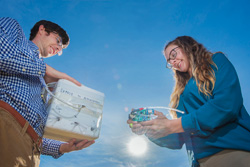
Sandia National Laboratories geophysicist Danny Bowman recently presented at the American Geophysical Union conference the results of an experiment in which he launched a fleet of five solar-powered balloons he built to detect the infrasound from a test explosion.
The results, which could have impacts on treaty monitoring and solar system exploration, are expected to be published soon.
Infrasound, which are frequencies below 20 hertz, is traditionally detected with ground-based sensor arrays. These ground-based arrays, however, cannot detect infrasound in the open ocean and can be hindered by other noises, such as the sound created by the wind and air conditioners.
As part of an experiment funded by Sandia’s Laboratory Directed Research and Development program, Bowman released a fleet of five solar-powered balloons, which rose into the stratosphere, at a height of 13 to 15 miles.
“The stratosphere is much less noisy so you can detect events of interest to science and national security from greater distances,” Bowman said.
Each of the five balloons has a microphone, allowing researchers to triangulate the source of the sound they detect.
Once launched, the balloons stay in the stratosphere all day and come down after the sun sets. Bowman said he is interested in creating a balloon design with an insulator on the top of the balloon and absorber on the bottom that could capture heat from the Earth, enabling it to fly at night.
Bowman has also proposed flying balloons equipped with infrasound sensors as a part of the next series of the National Nuclear Security Administration’s Source Physics Experiment project, which develops approaches to detecting underground nuclear explosions. He is also working on a NASA Jet Propulsion Laboratory project to explore the possibility of using the balloon-borne sensors on Venus to listen for Venus-quakes.
“This is a really exciting new area of research,” Bowman said. “Balloon-borne infrasound sensors will never replace ground-based acoustic arrays, but I think it can augment them. And the most exciting thing is flying in the atmospheres of other planets and what we can learn from them.”




